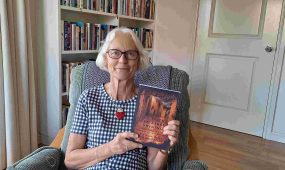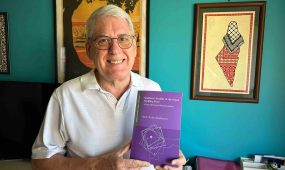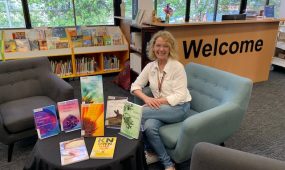I want to fix ears
Books & Guides
“Key themes of Clark’s story are his determination, persistence, underlying faith and love of family. His desire as a young boy to ‘fix ears’ was driven by observing his father and the challenges he faced, particularly working as a pharmacist,” says The Rev’d Lauren Martin

Graeme Milbourne Clark’s autobiography I want to fix ears: Inside the cochlear implant story tells the story of his life-long goal to “fix ears”. Even as a kindergartener, this was Clark’s goal (p.79). The inspiration to “fix ears” came through watching the challenges his deaf father faced.
This book describes Clark’s remarkable journey, through his studies and research, including the challenges and criticisms both he and his team faced developing the cochlear implant. Clark commenced his medical training in 1952, eventually performing the first cochlear implant operation on Rod Saunders on Tuesday 1 August 1978. After reaching a level of satisfaction with the progress of the cochlear implant, in 2000 Clark and his team expanded their work from cochlear implants to other related areas of biomedical engineering, such as researching the restoration of function after spinal cord injury, activating limbs or prostheses, the bionic eye and the diagnosis and treatment of epilepsy.
Throughout the book, the reader is invited to join Clark on his journey. This starts with the many challenges and unexpected turns Clark and his team faced, not just in developing and refining technology for the cochlear implant, but equally so the unexpected opposition to the project itself. One of the more unusual aspects of the journey, as it garnered much needed public attention and subsequent support, arose in 1972 “when [Clark] was approached by a [woman] who wanted [him] to see if [he] could cure her deaf dog…” (p.133). The opposition and criticism Clark and his team faced were broad-based, coming from the scientific, medical and Deaf communities. Clark felt that “it was ironic that [he] was now confronted by the very people [he] wanted to give an opportunity to hear” (p.226).
Key themes of Clark’s story are his determination, persistence, underlying faith and love of family. His desire as a young boy to “fix ears” was driven by observing his father and the challenges he faced, particularly working as a pharmacist. Throughout his career, Clark made time to be with his family and felt especially supported by his wife, stating to a reporter that “it was my wife, team, friends, doggedness and faith in God” (p.260) that sustained him through the many challenges he faced in the cochlear implant’s development. Early on in life Clark found understanding and meaning in both scientific enquiry and his faith in God, finding that both “science and faith in God are indeed compatible” (p18). He believes that God is central to finding truth and in the project’s success.
Advertisement
This book primarily focuses on Clark’s scientific journey towards the cochlear implant; however, it also contains reflections from a few notable recipients and their families. It is clear that, for Clark, those who were implanted were not merely part of the process or part of his job. He often built relationships with his patients as they worked together to refine the programming or attended various functions. The recipients were not immersed in the Deaf community, either becoming deaf later in life or born to hearing parents. Those deafened later in life found that the cochlear implant restored self-esteem, gave renewed purpose, and gave back “something unbelievable precious and uniquely human” (p.40). While those born deaf found that the implant gave them the choice to be part of the Deaf world or hearing world (Clark, 2021, pp. 31-34, 41-43, 52, 54, 60-62).
I found this book to be interesting both from a scientific perspective, and from my understandings of the Deaf community as someone working with parishes translating and presenting services and events in Auslan. Although having a cochlear implant has since become more acceptable in the Deaf community, it still can be a sensitive topic for some. As Clark mentions in his book, many Deaf community members do not see deafness as a disability or something that needs to be “fixed”, and therefore the significance and perceived value of the cochlear implant may not be as great as otherwise expected from a hearing perspective.
Advertisement
History has shown that cochlear implants do not work for everyone, and if they do work, recipients require extensive (months or even years) of speech therapy and learning how to process the new sensory input. The operation and implantation are just the beginning of the process.
Implantation with a cochlear implant and subsequent aural/oral approach to education can impact access to Deaf culture, which necessarily includes access to signed languages (there are many different sign languages, just like there are spoken languages).
Therefore some feel that implantation represents a loss for Deaf culture, or that the Deaf person is trying to make themselves “hearing” — after all, if they do not consider themselves “broken” or disabled in the first place they may ask “why receive an implant?” and “why turn away from one’s culture?”
I am encouraged by Clark’s love of his family, his faith in God, and his understanding of God’s presence guiding and enabling him in his work, despite the challenges he endured.
This book explores the vision and passion of one person standing at the forefront of scientific and medical progress of the time while he and his team developed the cochlear implant. This story reveals a man with a generous heart, wishing to help others and serve God. This book highlights a time of scientific discovery and progress and is an encouraging example of faith and trust in God.
I recommend this book to my fellow Anglicans, whether you have an understanding of science or not. It is not too “science-y” to be exclusionary, while providing enough substance for those interested in science and engineering. This book highlights a time of cutting edge scientific discovery, a discovery steeped deeply in God’s loving and consistent presence.
Graeme Clark, 2021. I want to fix ears: Inside the cochlear implant story. ISCAST, Forest Hill, Victoria.
Editor’s note: For more information on Deaf Community advocacy, please visit the Deaf Australia website.





